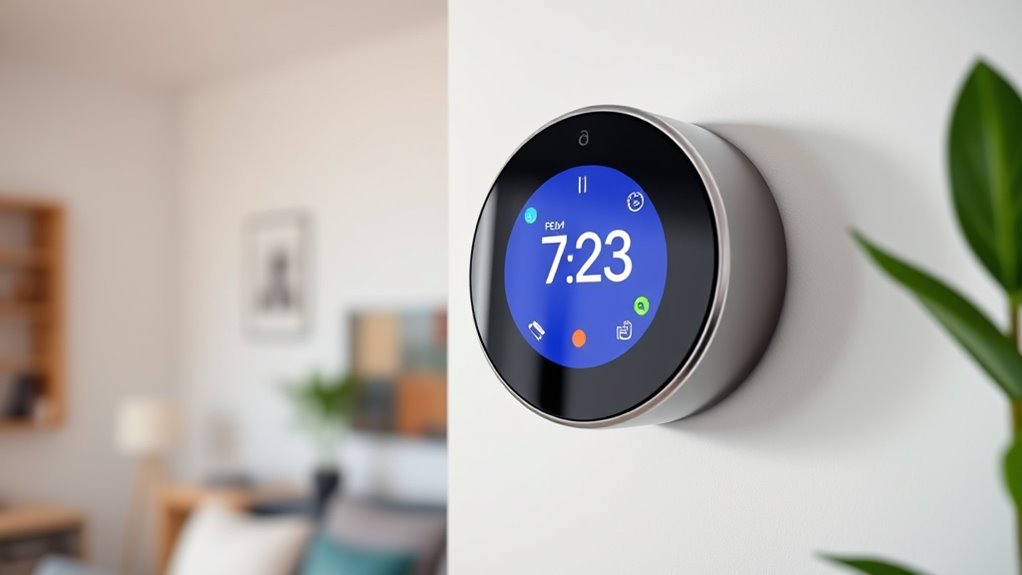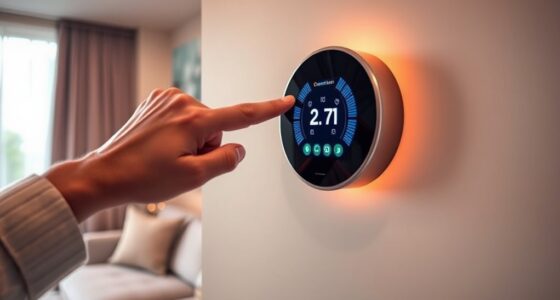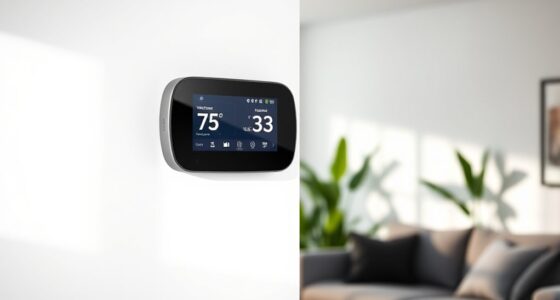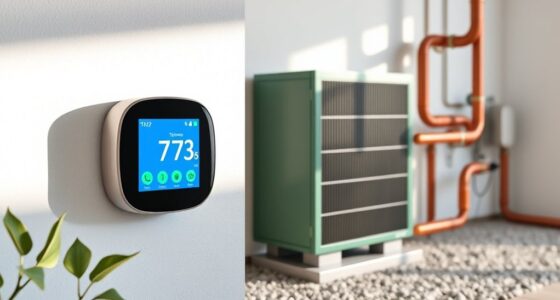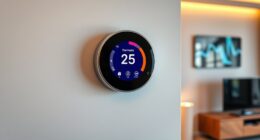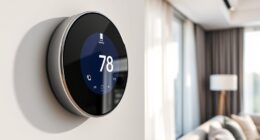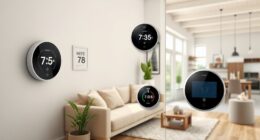To choose a budget-friendly smart thermostat, start by checking if it’s compatible with your HVAC system and existing wiring, especially if you don’t have a C-wire. Look for models that offer essential smart features like app control and voice assistant support without extra costs. Keep placement in mind—avoid areas with drafts or heat sources for better accuracy. If you keep these tips in mind, you’ll find a great, affordable option that still offers convenience and savings.
Key Takeaways
- Identify models that offer essential smart features at lower prices without excessive extras.
- Check compatibility with your existing HVAC system and Wi-Fi setup to avoid costly upgrades.
- Look for thermostats with universal wiring options or C-wire compatibility for easier installation.
- Consider brands with good customer reviews for reliability and basic functionality within your budget.
- Utilize online deals, discounts, or refurbished options to get quality smart thermostats at reduced costs.
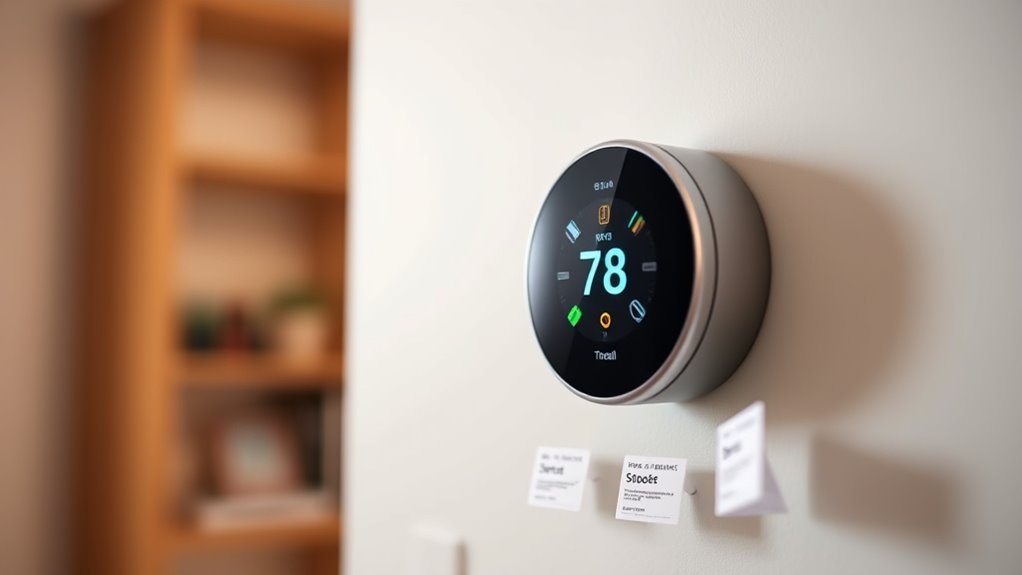
Are you looking to upgrade your home’s heating and cooling system without breaking the bank? A budget-friendly smart thermostat can help you save energy and improve comfort without draining your wallet. When choosing one, it’s essential to keep in mind that installation tips can make a big difference in how smoothly the process goes and how well your new device performs. Start by guaranteeing you turn off your power supply before beginning any installation to avoid electrical mishaps. Carefully remove your old thermostat, taking note of how the wires are connected. Many affordable smart thermostats come with detailed installation guides—be sure to follow these carefully. Some models even feature step-by-step video tutorials that can make the process simpler.
Compatibility considerations are just as vital as installation tips. Not all smart thermostats work with every HVAC system, so you’ll want to double-check that your chosen model is compatible with your heating and cooling setup. If you have a common system like a central air conditioner and furnace, most budget-friendly options will work, but if you have a more complex or older system, you might need a model with specific compatibility features. Take the time to review your system’s wiring and communication protocols—some thermostats connect via Wi-Fi only, while others may need a C-wire for power. If you don’t have a C-wire, look for a thermostat designed to operate without one or consider installing a C-wire if possible.
Ensure your smart thermostat matches your HVAC system’s wiring and communication protocols for seamless operation.
When selecting a budget-friendly smart thermostat, also consider its compatibility with your smart home ecosystem. Some models work seamlessly with voice assistants like Alexa, Google Assistant, or Apple HomeKit, which can add convenience to your daily routines. Checking customer reviews can also give you insight into potential compatibility issues others have faced. Additionally, understanding the role of color accuracy in smart devices can ensure your thermostat’s display is clear and easy to read under various lighting conditions.
In terms of installation tips, guarantee your thermostat is placed in a location that accurately reflects your home’s temperature—away from drafts, direct sunlight, or heat sources. Proper placement ensures your thermostat can effectively learn your schedule and optimize comfort. Don’t forget to connect to your Wi-Fi network during setup to access remote control features and energy reports. Once installed, test your system thoroughly to confirm everything functions correctly.
Choosing a budget-friendly smart thermostat doesn’t have to be complicated if you pay attention to compatibility considerations and follow sound installation tips. Doing so guarantees you get a device that works well with your system, is easy to install, and provides the energy savings and convenience you’re looking for—all without overspending.
Frequently Asked Questions
Can I Install a Smart Thermostat Myself?
Yes, you can do a DIY installation of a smart thermostat, but you should first check compatibility concerns with your heating and cooling system. Make sure your thermostat is compatible and follow the manufacturer’s instructions carefully. Turn off power before starting, and use a screwdriver for wiring. If you’re unsure about the wiring or system compatibility, it’s safer to consult a professional. Proper installation guarantees ideal performance and safety.
Do Budget Thermostats Work With All HVAC Systems?
Ever wonder if budget thermostats work with all HVAC systems? They often have compatibility concerns, especially with complex or older setups. While many budget-friendly options are designed for common systems, some may face installation challenges or lack features needed for your specific setup. Always check the thermostat’s compatibility list before buying. Are you prepared to troubleshoot potential issues, or should you consider a higher-end model for seamless integration?
How Secure Are Smart Thermostats From Hacking?
Smart thermostats are generally secure, but cybersecurity concerns do exist. You can protect your device by regularly updating its firmware, using strong, unique passwords, and enabling two-factor authentication. Be mindful of data privacy; review privacy policies to understand how your data is stored and shared. Taking these steps reduces hacking risks and keeps your smart thermostat secure, ensuring your home stays comfortable without compromising your security.
Will a Budget Thermostat Save Me Money?
A budget thermostat can be your savings wizard, turning energy bills into a thing of the past. It works like a smart dance partner, adjusting to your routines and maximizing energy savings. While it may lack fancy features, it still offers user compatibility that keeps your home cozy without breaking the bank. As you learn its rhythms, you’ll see your utility costs shrink, proving affordability doesn’t mean sacrificing comfort.
Are There Any Subscription Fees for Smart Thermostats?
Most smart thermostats don’t have ongoing subscription fees, so you won’t need to worry about recurring costs. However, some models offer optional subscription plans for extra features or advanced analytics. You can usually access free app features like remote control, scheduling, and energy usage insights, which enable you to save money and customize your comfort. Always check the specific thermostat’s details to avoid unexpected subscription costs.
Conclusion
Choosing a budget-friendly smart thermostat is like finding a hidden gem that saves you money while keeping your home cozy. By comparing features, reading reviews, and sticking to your budget, you’ll make a smart choice that fits your needs without breaking the bank. Remember, the right thermostat is the key to a comfortable home and smarter energy use. So go ahead, pick one that suits your wallet and turns your house into a cozy haven on a dime.
